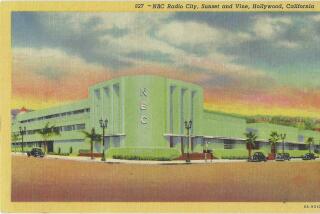A MARS Music Invasion : The 3-month-old Santa Monica-based FM station hopes to equal the success of KROQ’s influential ‘Roq of the ‘80s’ format
This was like something out of 1982 FM radio. Here was air personality Raechel Donahue talking with singer Dale Bozzio over the afternoon airwaves about recent career moves, and spinning a turntable with her guest’s old Missing Persons hit “Walking in L.A.”
For a few moments, it sounded like the early “new wave” days of KROQ-FM all over again. But even if the new MARS-FM (103.1) shares some important roots with that older modern rock station, executives at the 3-month-old Santa Monica-based MARS insist that their goal is to have as dramatic an effect on local radio in the 1990s as KROQ did with its influential “Roq of the ‘80s” format.
MARS is attempting this with a mix of up-tempo industrial dance music and more melodic modern rock from the likes of Siouxsie and the Banshees, Depeche Mode and Big Audio Dynamite. Donahue, whose L.A. radio career began in the 1960s and included a highly rated stint as Rick Dees’ sidekick on KIIS-FM, said her 20-year-old son has already told her that the dance-minded mix marks “the first time in about 10 years that he’s been able to listen to where I’ve worked. And heaven knows I’ve been everywhere else.”
MARS-FM launched its “new music invasion” May 24 out of the humble second-floor offices of KSRF-FM, a regional Santa Monica station five blocks from the beach that had mostly played “easy listening” music. MARS’ new signal is simulcast on that station and on KOCM-FM in Newport Beach, another 3,000-watt station that shares the same frequency and a new owner, Ken Roberts, the former owner of KROQ-FM (106.7).
General Manager John McLaughlin, who came on board after the sale last year to Roberts, said 70% of the first MARS playlist was music not played on any other local frequency. Some of those new tracks, he said, have since been added by other local stations. But with a team that includes Program Director Freddy Snakeskin, Music Director Egil Aalvik (“The Swedish Eagle”), Donahue and McLaughlin--all KROQ veterans--immediate comparisons to that other station were unavoidable.
And yet, Roberts repeatedly insisted that MARS was not an attack on the station he sold in 1986 to Infinity Broadcasting for $45 million. He is merely looking to spark a “progression” in local rock radio, he said. “I think people really want new music.”
But at KROQ, Program Director Andy Schuon predicted that the effect of the combined signals of KSRF and KOCM, still the official call letters of MARS, would be “very limiting.” Schuon said he was unable to hear the MARS signal in his office in Burbank, which would also be true in certain other parts of the Valley.
And despite any similarities in their playlists, he doesn’t see MARS as any more significant a competitor than several other local stations in the crowded radio market. “There’s 70 stations in Los Angeles, and we all compete ultimately,” he said. “Everyone is trying to find a niche, and that’s difficult in a fragmented market like this.”
Schuon said he doubted that the new station’s churning beat would find a large audience, particularly since when KROQ went in a similar direction a few years ago, playing more dance-oriented music, ratings dropped to an all-time low. “People can only take that for so long,” he said.
Others are also unsure that the underground dance club staple can translate to the airwaves. “Only a certain amount of the population likes alternative music, and only a certain amount likes dance music all the time,” said Craig Rosen, who writes about radio for Billboard magazine. “And where those two populations intersect, I don’t know if that audience is going to be big enough to sustain a radio station.
“It’s an interesting idea,” he said. “I always welcome trying new things on radio. But the harsh economic realities say that it’s doubtful.”
During the year leading up to MARS’ debut, Roberts and McLaughlin looked at five possible formats for the new station, including classical, jazz, big band and easy listening. The modern dance-rock format urged by Snakeskin was chosen in part, McLaughlin said, because that sound would clearly separate MARS from the two stations closely flanking it on the FM dial: KIIS-FM (102.7) and KOST-FM (103.5).
The MARS-FM project has also required spending about $500,000 so far just on the new technology required to broadcast the same signal on two regional stations simultaneously on a single frequency. It’s a setup that may be unique, said Larry Eads, chief of the Federal Communications Commission’s audio services division.
“The engineering marvel of what’s happening here is probably, by and large, the biggest success and will always overshadow the music success we aspire to have,” McLaughlin said.
A few hours after Donahue’s talk with Bozzio, Snakeskin is playing the Orb’s thumping “Perpetual Dawn” on his afternoon drive-time show. The host is sitting behind the control board, casually loading and unloading turntables, CD players and tape cassette decks.
“You’re listening to the new MARS-FM,” he announces. “We play all the music all the other stations are afraid to play. But it’s really very nice music.”
The room is small, unglamorous with white bricks and pipe on one side, crowded with album and CD shelves, and not unlike KROQ’s original headquarters in Pasadena. “A lot of the vibes are similar,” Snakeskin said of the station he left in early 1990. “But this is different in that we’re able to create this whole thing according to some kind of plan, as opposed to inheriting something and gradually trying to fix it.
“We have the advantage also that Ken has some money now,” he said. “Back then he didn’t have any money. He had the license to the station and whatever advertising money came in.”
Within 10 days of going on the air, a mail delivery to MARS brought a KROQ T-shirt ripped down the middle, with desperate scribblings written on the inside. The message read, in part, “On Saturday May 25 1991 I found a new station on my stereo . . . Please don’t change a thing. It’s awesome, and send me a real T-shirt.”
Aalvik said, “People want what’s played in the underground clubs now. That’s the new happening thing. And that’s going to cross over one day.” He fully expects “a good portion” of the MARS-FM playlist to ultimately land on Top 40 radio.
In spite of the “new music” label attached to the MARS playlist, much of this music has been around for a few years, though heard mainly in underground dance clubs.
“The record companies want to stay ahead,” said Aalvik. “They go to England and Europe to look for new artists.” As an example, he said the British band Nitzer Ebb “has been on an American label for a long time, but they’ve never been on an FM radio station in Los Angeles.”
“This station is the alternative, and it is history repeating itself,” Roberts said, insisting the fall Arbitron ratings will prove him right. “And it has nothing to do with KROQ. It has to do with a simple formula: Try something new.”
Roberts said his acceptance of music rarely broadcast on American radio stems from his “hands-off approach” to the station, which inspired the creativity and sharing of ideas among staff members that led to KROQ’s early successes. “It wasn’t just one person,” he said.
He noted also that KROQ dropped from third place to 20th soon after it was sold. Roberts attributed some of this sudden decline, which was quickly reversed, to Infinity Broadcasting’s new focus on a more corporate, computerized bureaucracy.
Still, Roberts and the others acknowledged that there is some real risk in introducing an untested format. Recent years have witnessed the failure of other local stations that had promoted themselves as on the cutting edge of rock radio. Among those was KEDG-FM (“The Edge”), a station that mixed traditional album rock in the late ‘80s with more adventurous material, and where Donahue worked during its brief existence.
“It was real progressive,” Donahue said. “But even though the format was very broad, the structure of the radio station itself was really rigid. There wasn’t any opportunity to talk to anybody on the phone, they didn’t take requests. There wasn’t that much personal contact with the people.”
And Aalvik said he understands that many of KROQ’s current listeners would not accept some of the MARS danceable playlist.
MARS is looking for new audiences as well, including what Aalvik sees as an untapped Latin dance crowd.
“It’s not something that’s just going to be limited to here in Los Angeles. It will be all across the country within six to eight months,” McLaughlin predicted. “There will be a major station in every market doing what we are here.”
More to Read
The biggest entertainment stories
Get our big stories about Hollywood, film, television, music, arts, culture and more right in your inbox as soon as they publish.
You may occasionally receive promotional content from the Los Angeles Times.











